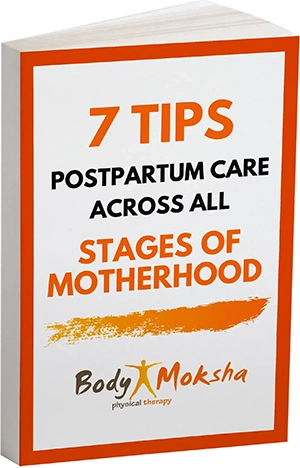7 Tips Postpartum Care Across All Stages Of Motherhood
BIO:

Since 2002, Dr. Tejal Ramaiya has been helping athletes and active adults get back to the workouts and training they’re missing out on when everything else has let them down. Since she graduated with her Master’s in Physical Therapy in 2002 and then her Doctorate in Physical Therapy in 2004 from University of Medicine and Dentistry of New Jersey, she has been working with active adults on a daily basis. The majority of her clientele are triathletes but she also really enjoys working with active adults, Golfers, Yogis, Pilates enthusiasts, CrossFitters and High School Athletes.
Over the years, she has earned a number of specialized certifications which make her well equipped to work with this active population. Some of these include:
Certification in Strength and Conditioning Trigger Point Dry Needling
Kinesiotaping Graston technique
Titleist Performance Institute Golf Fitness Professional
Functional Movement Screening and Selective Functional Movement Assessment
When not at work, she enjoys hiking, chilling at the beach, and taking fun vacations with her family.
Introduction
We see it all too often. Once a woman has safely delivered her child, the medical attention typically shifts primarily to her child. There is not enough postpartum care for women. Things like vaginal pain or incontinence is written off as something to just deal with because “it happens to everyone”. Just because something may be common does not mean that it is normal! More importantly, it is crucial that you know there are medical providers like pelvic floor physical therapists that are here to listen to you, take your concerns seriously, and have tools available to help you.
Additionally, pelvic floor physical therapists are available to you no matter how long you have earned the title mom. Dysfunction acquired during your postpartum window can continue to persist throughout the lifespan and oftentimes worsen with age. Here are some tips and tricks you can use to help you on your postpartum journey.
FOR THE NEWER MOMS…
TIP #1: 6 WEEK HIATUS
Many of our clients are quite eager to return to their normal exercise routines immediately after giving birth. It is our recommendation that you wait for at least 6 weeks following delivery prior to returning to your usual exercise routine and before you report to physical therapy for a pelvic exam. This ensures enough time for the proper healing of the tissues of your pelvic floor. It is also our experience that many women report high levels of fatigue in those first few weeks due to their change in sleep patterns. Use your free moments to catch up on sleep, bond with your baby, and be kind to yourself.
TIP #2: CHILL OUT
It is common to have soreness in the perineum and vagina following vaginal deliveries. It can make it difficult to even sit down or get comfortable when trying to sleep. One safe way to alleviate the soreness is to put some aloe or witch hazel on a sanitary pad, freeze it, and apply it to your underwear like you would a normal pad. These cooling and soothing tools are playfully named padsicles. There are brands of premade ones you can find online as well.
TIP #3: SUPPORT IS KEY
In addition to your village of people helping to support you, be sure that you are taking care to support your body throughout the day. This means being mindful of the position your body is in when feeding your baby, carrying your baby, folding laundry, etc. Get a pillow or a boppy and place it under your arm when feeding your baby to avoid any increased arm or neck pain. When folding laundry or changing your baby, do it on a surface level that allows you to be standing straight up to avoid back injuries from leaning forward. We see so many women for aches and pains that could have been avoided had they been given positional advice from their physical therapist.
FOR ALL MOMS…
TIP #4: TAKE 5
It can be very difficult to have a minute to yourself after having a baby or having multiple children. When a big part of your life is caring for others, your needs often get overlooked. Some women may even feel guilty for taking time to relax. Take this as your permission to do so. Try laying down or sitting in a comfortable position and breathe deep and full into your belly for 5 minutes. This will help you draw attention to how your body and mind feels and is a great first step towards reconnecting with your body.
TIP #5: WALK THE WALK
Take a quick walk around your neighborhood or a park. This can be for any amount of time, but getting about four 30 minute walks in a week can help you gently return to any exercise you used to do and will help release endorphins afterwards. Those are those feel good hormones.
Bring your stroller, bring a friend to chat, or just hang by yourself!
TIP #6: MIND THE GAP
Many patients come in with concerns about a potential or newly formed diastasis recti, or a gapping between their abdominal muscles that can range from very mild to severe. Any change to the mechanics of the core muscles can lead to dysfunction with stabilization through the core, low back, hips, and pelvis. A pelvic floor physical therapist can evaluate you to see if you have a separation and if you do they will be able to tell you the severity of the gap.
The best way to address this is through core stabilization exercises that focus on training the abdominal muscles to contract while back in the position they normally would be in. Your therapist may also perform taping of the muscles to help retrain them to activate in an appropriate position.
TIP #7: RETURN TO EXERCISE
After at least 6 weeks of rest after delivery, it is very important to begin adding in hip and core strengthening exercises to be able to return to any activity that brings you joy, like running, playing tennis, peloton, pilates, etc. This strengthening will help to re-teach your muscles how to produce the strength they need to to support you during those activities so you can do them efficiently and without pain. Most commonly, we see low back pain but it is not impossible to have neck, upper back, or shoulder pain as well.
Not sure where to start? See a pelvic floor physical therapist to assess your strength and recommend exercises that will create a strong foundation for strength.
MEDICAL DISCLAIMER
We make every effort to ensure that we accurately represent the injury advice and prognoses dis- played throughout this Report.
However, examples of injuries and their prognosis are based on typical representations of those injuries that we commonly see in our Physical Therapy clinics. The information given is not intended as representations of every individual’s potential injury. As with any injury, each person’s symptoms can vary widely and each person’s recovery from injury can also vary depending upon background, genetics, previous medical history, application of exercises, posture, motivation to follow Physical Therapist advice and various other physical factors.
It is impossible to give a 100% completely accurate diagnosis and prognosis without a thorough physical examination and likewise the advice given for management of an injury cannot be deemed fully accurate in the absence of this examination from one of the physical therapists at Body Moksha Physical Therapy.
We are able to offer you this service FREE of any charge. Significant injury risk is possible if you do not follow due diligence and seek suitable professional advice about your injury. No guarantees of specific results are expressly made or implied in this report.


Privacy Policy: We guarantee 100% privacy. Your information will NOT be shared.


